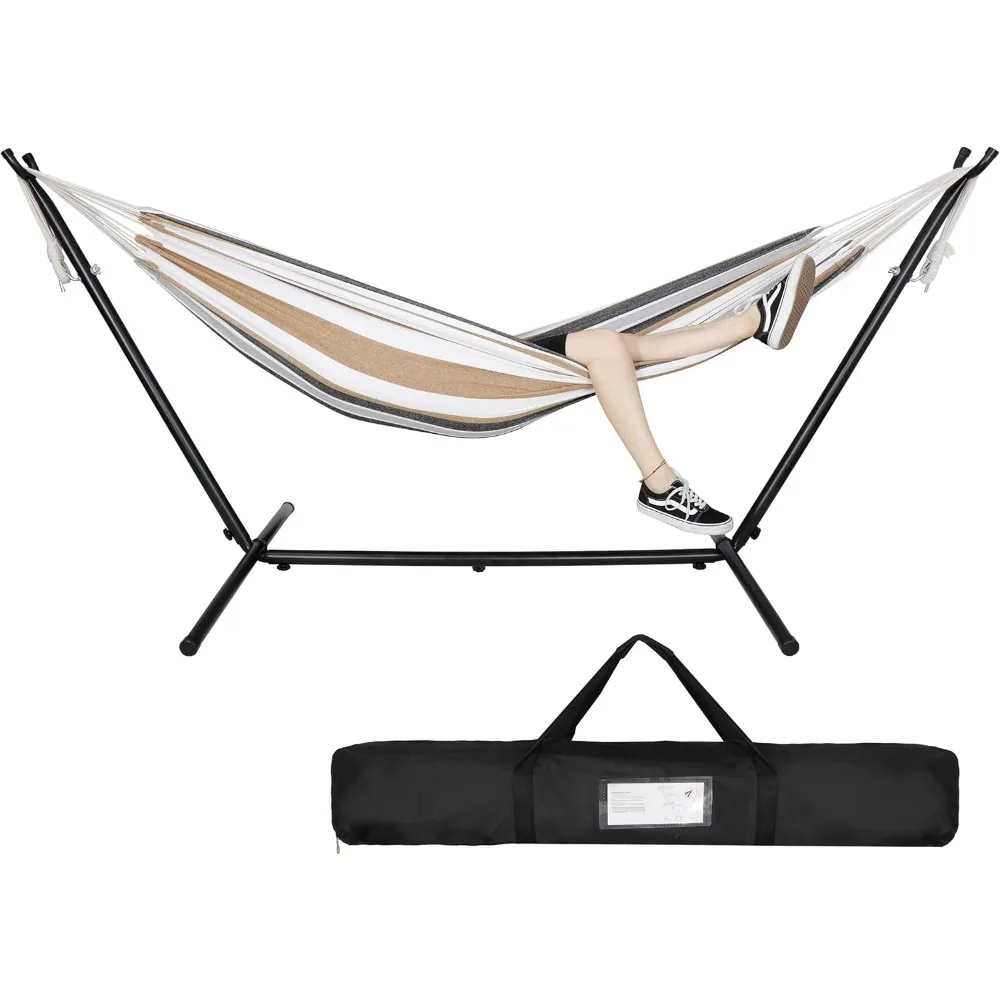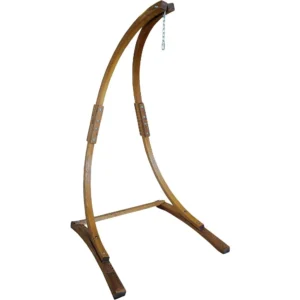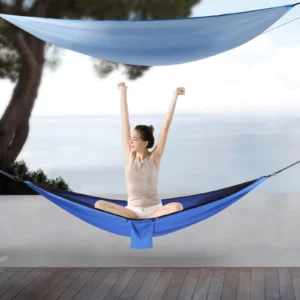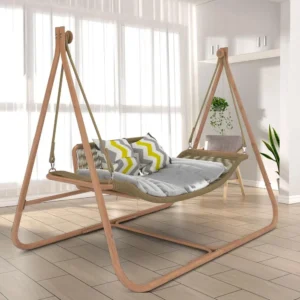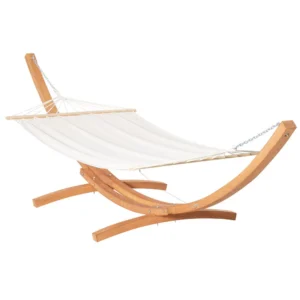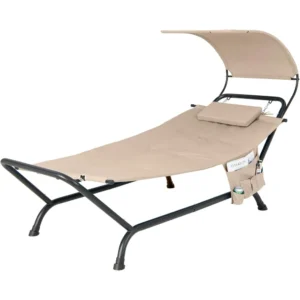Finding the perfect spot for your hammock can transform an ordinary relaxation session into a truly transcendent experience. Whether you’re looking to create a cozy reading nook indoors or a peaceful retreat in your backyard, the location of your hammock plays a crucial role in maximizing comfort and enjoyment. This guide will walk you through everything you need to know about hanging your hammock in the ideal spot, both inside and outside your home.
Safety Principles: What You Need to Know Before Hanging Any Hammock
Before you start dreaming about swaying in your hammock, it’s essential to understand some fundamental safety principles that apply to all hammock installations.
Safety should always be your first priority when hanging a hammock. Different hammock types have different weight capacities that you must respect. Single hammocks typically support 250-300 pounds (113-136 kg), while double hammocks can hold 400-500 pounds (181-227 kg). Always check the manufacturer’s recommendations for your specific hammock.
The structural integrity of your hanging points is non-negotiable. Whether you’re hanging from trees, wall studs, or ceiling joists, these supports must be solid and capable of handling dynamic weight (more than just the static weight of the occupants).
Key safety points to remember:
- Always hang your hammock at a 30° angle from the horizontal for optimal comfort and weight distribution
- Position your hammock so it sits about 18 inches (45 cm) from the ground when occupied
- Use appropriate hardware rated for at least 300% of the expected weight load
- Regularly inspect all hanging hardware, straps, and the hammock itself for wear or damage
Understanding proper hammock installation requirements and safety guidelines is essential before proceeding with any setup. The right hardware typically includes tree straps, carabiners, eye bolts, or specialized hammock hanging kits, depending on your chosen location.
Finding the Perfect Trees: The Classic Outdoor Hammock Setup
There’s something wonderfully traditional about hanging a hammock between two sturdy trees. This classic setup offers both practical support and a natural, relaxing environment.
When selecting trees for your hammock, look for these important characteristics:
- Diameter of at least 6 inches (15 cm) for adequate strength
- Healthy, living trees with no signs of disease or damage
- Optimal distance between trees of 14-16 feet (4.3-4.9 meters) for standard hammocks
- No sharp branches or obstacles between or around the trees
To protect trees while ensuring a secure hang, always use tree-friendly straps that are at least 0.75-1 inch (2-2.5 cm) wide. These distribute pressure across the bark rather than cutting into it. Avoid using rope directly against tree bark as it can cause damage over time.
Many tree species work well for hammock hanging, with hardwoods like oak, maple, and beech being particularly reliable choices due to their strength and stability.
If your trees aren’t perfectly spaced, don’t worry. You can use longer straps or extenders to compensate for trees that are further apart, or create a more diagonal hang for trees that are too close together.
Understanding whether it’s okay to leave your hammock outside in various weather conditions will help extend its lifespan. For outdoor use, consider exploring our selection of camping hammocks with stands designed specifically to withstand outdoor elements.
Beyond Trees: Creative Outdoor Hanging Spots
Don’t have perfectly spaced trees? No problem! There are plenty of alternative outdoor locations to hang your hammock and still achieve that perfect relaxation zone.
Porches and decks make excellent hammock spots, provided their posts are sturdy enough. For deck or porch posts, ensure they’re at least 4×4 inches (10×10 cm) and securely anchored. Always attach to structural posts, not decorative railings.
Pergolas and gazebos can create beautiful hammock settings, but verify their construction can support dynamic weight. Most well-built pergolas can accommodate a properly hung hammock.
For those without natural attachment points, consider installing dedicated hammock posts. These should be:
* Set at least 2 feet (0.6 meters) into the ground with concrete
* Spaced according to your hammock length (typically 14-16 feet/4.3-4.9 meters apart)
* At least 4×4 inches (10×10 cm) in thickness for wooden posts
Balconies can work for smaller hammocks or chairs, but exercise extreme caution and only attach to structural elements. Always check weight limits and building regulations before installation.
For unique outdoor setups, consider poolside installations using specialized stands, or even temporary setups between vehicles while camping (using roof racks or truck beds as anchor points).
Each location requires specific hardware:
* Wood surfaces: Use lag bolts or eye bolts with washers
* Concrete or stone: Use expansion bolts or epoxy anchors
* Metal structures: Use U-bolts or through bolts with backing plates
Finding the perfect hammock placement for your home or garden depends on your specific outdoor space and needs. For added protection from the elements, our hammock sets with canopy provide built-in shelter while enjoying your outdoor space.
Indoor Hammock Prerequisites: Understanding Your Home’s Structure
Bringing your hammock indoors creates a year-round retreat, but requires understanding your home’s structural elements to ensure safe installation.
The most crucial step for indoor hammock hanging is finding structural supports—typically wall studs or ceiling joists. These are the only elements strong enough to safely support the dynamic weight of a hammock and its occupants.
To find these supports:
* Use a stud finder to locate wall studs (typically spaced 16 or 24 inches/41 or 61 cm apart)
* For ceiling joists, start at the wall and measure in 16 or 24 inch increments
* Always verify with a small test drill and by feeling resistance
* Mark locations clearly before installation
Different building types present unique challenges. Modern homes typically use standardized construction with predictable stud placement, while older homes may have irregular framing or even masonry walls requiring specialized anchors.
For proper indoor installation, use hardware rated specifically for hammocks:
* Eye bolts (at least 3/8-inch/10mm diameter) that penetrate at least 3 inches (7.6 cm) into the stud
* Heavy-duty anchors for masonry walls
* J-hooks or hammock-specific ceiling mounts for joists
Always be mindful of weight distribution. A hammock puts unusual directional force on attachment points that standard household fixtures aren’t designed to handle.
Understanding whether it’s safe to hang a hammock indoors is essential before proceeding with any indoor installation project.
Living Room Hammock Havens: Creating a Relaxation Focal Point
The living room offers a perfect opportunity to make your hammock both a functional retreat and a striking design element. When properly placed, a hammock can become the conversation piece your living space has been missing.
Optimal living room placements include:
* Across corners, which maximizes space efficiency and creates a cozy nook
* Parallel to windows, allowing natural light while reading or relaxing
* As a room divider in open-concept spaces, defining zones without walls
For a hammock to fit comfortably in a living room, you’ll typically need at least 7×10 feet (2.1×3 meters) of clear space. Consider the full arc of the hammock when occupied, not just its straight-line length.
When integrating your hammock with existing décor, treat it as a furniture piece rather than an afterthought. Choose hammock colors and styles that complement your existing color palette and design aesthetic. Brazilian hammocks with their vibrant colors work beautifully in bohemian or eclectic spaces, while neutral-toned rope or quilted hammocks suit minimalist or contemporary designs.
For living rooms where floor space is at a premium, consider wall-mounted options that can fold away when not in use, or hammock chairs that require significantly less space than full-size models.

For more creative ideas on the best places to hang a hammock indoors, explore our detailed guide. Space-conscious design solutions are available in our collection of hammock chairs and stands that work beautifully in living areas.
Bedroom Retreats: Creating Your Perfect Sleep or Reading Nook
Bringing a hammock into your bedroom creates a personal sanctuary for relaxation, reading, or even alternative sleeping arrangements. The intimate nature of bedrooms makes them ideal for hammock integration.
Popular bedroom hammock placements include:
* In the corner, creating a dedicated relaxation zone
* Near windows to capitalize on natural light for reading
* As an alternative bed (particularly popular in studio apartments)
When using a hammock for sleeping, consider a Brazilian or Mayan style, which are designed for overnight comfort with their diagonal lay. These styles allow for a flatter, more ergonomic sleeping position than rope hammocks.
Even in smaller bedrooms, hammock integration is possible. A hammock chair in a 4×4 foot (1.2×1.2 meter) corner can create a perfect reading nook without overwhelming the space. For standard hammocks, ensure at least 7 feet (2.1 meters) of length and account for the natural curve when occupied.
To integrate with existing furniture, position your hammock away from sharp edges or hard surfaces. Consider the visual balance of the room—a hammock works well as either a subtle addition or a bold focal point, depending on its style and your design preferences.
Our swinging hammock chair sets provide excellent space-efficient options for bedroom relaxation without requiring the full footprint of a traditional hammock.
Sunrooms, Porches & Transitional Spaces: Bringing the Outdoors In
Transitional spaces like sunrooms, screened porches, and covered patios offer the perfect middle ground between indoor comfort and outdoor ambiance for your hammock.
These spaces uniquely combine protection from harsh elements while maintaining connection to nature. For hammock enthusiasts, this means enjoying outdoor relaxation without worrying about sudden rain, intense sun, or pests.
When installing hammocks in these areas, consider:
* Exposure to UV rays through windows (select fade-resistant fabrics)
* Humidity levels (choose mildew-resistant materials)
* Temperature fluctuations (add blankets or pillows for year-round comfort)
Structurally, these spaces often offer excellent mounting options, including exposed beams, solid framing, or purpose-built posts. Always verify the construction can support dynamic weight before installation.
For seasonal considerations:
* Summer: Choose breathable cotton or lightweight synthetic fabrics
* Winter: Add outdoor heating nearby and opt for insulating materials
* Spring/Fall: Have light blankets accessible for temperature changes
The unique lighting in these spaces enhances the hammock experience—morning sun in an east-facing sunroom creates an energizing start to the day, while evening light in a west-facing porch offers a perfect sunset retreat.
For additional guidance on setting up hammocks in these semi-protected areas, review our guide on setup tips for hammock chairs with roof protection. Our collection of porch swing chair sets is specifically designed to thrive in these transitional spaces.
Creative Indoor Installations: Unexpected Places for Your Hammock
Thinking beyond conventional rooms can yield surprisingly perfect hammock spots that maximize both space efficiency and unique relaxation experiences.
Consider these creative indoor locations:
* Under loft beds or in lofted spaces
* In the space beneath stairs
* Across wide hallway ends or in hallway nooks
* Within home office spaces for productive breaks
* In finished basements as part of recreation areas
For apartments or smaller homes with limited wall space, look for:
* Doorway hammock bars that install without permanent fixtures
* Over-sized closets that can be converted to relaxation nooks
* Room dividers or free-standing frames that require no wall mounting
Hammock chairs are especially versatile for unconventional spaces. A single strong ceiling joist can support a hammock chair that requires just 3-4 square feet (0.9-1.2 square meters) of floor space—perfect for apartment dwellers or those with minimal square footage.
For children’s spaces, hammocks create magical reading nooks or play areas. Just ensure they’re hung lower to the ground (12-15 inches/30-38 cm when occupied) and supervise younger children.
Renters can explore temporary solutions such as:
* Tension-mounted poles (similar to shower curtain rods but stronger)
* Free-standing hammock stands
* Door frame attachments that use pressure rather than hardware

Understanding the differences between indoor vs. outdoor hammocks will help you select the appropriate style for these creative installations.
Hammock Stands: The Ultimate Versatile Solution
Hammock stands offer the perfect solution for those who want flexibility in their hammock placement or cannot modify their living space with permanent hardware.
Different types of stands provide various benefits:
| Stand Type | Best For | Weight Capacity | Portability | Price Range |
|---|---|---|---|---|
| Metal (Steel) | Durability, High Weight Capacity | 450-600 lbs (204-272 kg) | Moderate | $$ |
| Metal (Aluminum) | Lightweight, Portability | 250-400 lbs (113-181 kg) | High | $$-$$$ |
| Wooden | Aesthetics, Indoor/Outdoor Use | 300-500 lbs (136-227 kg) | Low | $$$-$$$$ |
| Portable | Travel, Temporary Setup | 250-350 lbs (113-159 kg) | Very High | $-$$ |
The primary advantage of stands is their versatility—they can be moved from room to room or from indoors to outdoors as seasons and needs change. No installation is required, making them ideal for renters or those who prefer not to drill into walls.
Space requirements vary by design:
* Traditional arc stands need approximately 14-15 feet (4.3-4.6 meters) of length
* Newer compact designs can fit in as little as 8-10 feet (2.4-3 meters)
* Height clearance of at least 4.5 feet (1.4 meters) is recommended
For aesthetics, wooden stands offer a warm, natural appearance that complements home interiors beautifully, while metal stands provide clean, modern lines that work well in contemporary spaces.
Weather considerations are important for outdoor stand use:
* Wooden stands should be sealed or treated for outdoor exposure
* Metal stands should be powder-coated or rust-resistant
* All stands benefit from covers or indoor storage during harsh weather
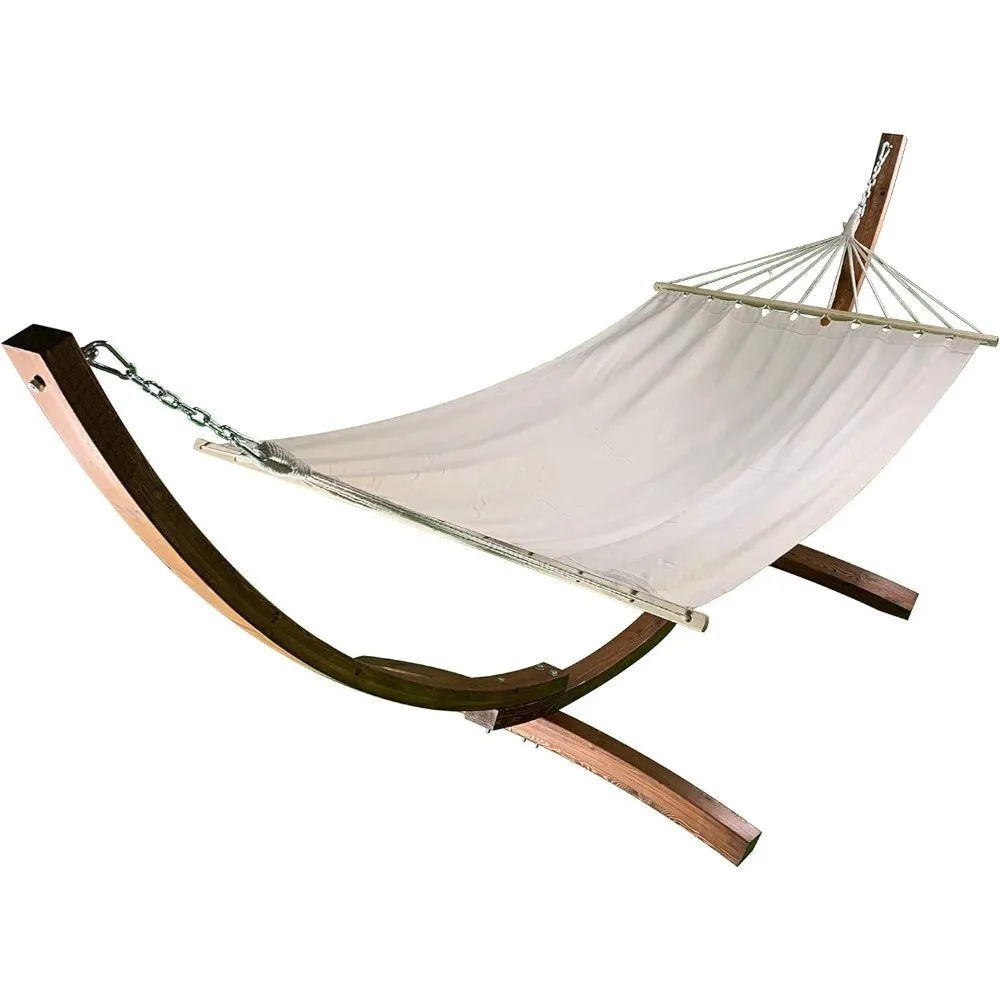
For a comprehensive comparison of placement options, our guide to indoor and outdoor hammock placement offers detailed insights. Our collection of wooden hammocks and stands provides aesthetically pleasing options that enhance any space.
Choosing the Right Hammock for Your Space
The perfect hammock location deserves the perfect hammock style. Different spaces and uses call for specific hammock types to maximize comfort and functionality.
Brazilian hammocks, with their tight weave and soft cotton, excel in indoor settings where their comfort and decorative appeal shine. Their colorful designs make them statement pieces in living rooms and bedrooms.
Rope hammocks offer a classic look that works well in traditional outdoor settings like between trees or on porches. Their open weave provides excellent ventilation for hot climates but offers less privacy in public spaces.
Quilted hammocks combine comfort with weather resistance, making them ideal for semi-protected areas like sunrooms or covered patios. Their padded design provides insulation, extending your hammock season into cooler months.
Camping or parachute hammocks, made from lightweight nylon, are excellent for portable use and temporary setups. Their quick-drying, mildew-resistant properties make them suitable for poolside or lake areas.
Size considerations are crucial:
* Single hammocks (4-5 feet/1.2-1.5 meters wide) work best in limited spaces
* Double hammocks (5-6 feet/1.5-1.8 meters wide) offer more comfort but require larger areas
* Family-sized hammocks (7+ feet/2.1+ meters wide) need substantial space and very strong anchor points
Material selection should match your environment:
* Cotton: Comfort and breathability for indoor use
* Polyester: Durability and fade resistance for sunny outdoor spots
* Weather-treated fabrics: For exposed outdoor locations
* Acrylic or Sunbrella: Maximum weather resistance for permanent outdoor setups
For comprehensive advice on selecting the optimal location, our guide on the best place to put a hammock covers all environments. For sharing relaxation with a partner, our double two-person hammock sets provide spacious comfort.
Dark Wood Hammock Sets, Porch Swing Chair Sets
$653.82 Select options This product has multiple variants. The options may be chosen on the product pageA-Frame Stand Hammock Sets, Swinging Hammock Chair Sets
$154.62 Select options This product has multiple variants. The options may be chosen on the product pageCamping Hammock Sets with Bug Net, Ultralight Camping Hammock Sets
$139.72 Select options This product has multiple variants. The options may be chosen on the product pageLight Wood Hammock Sets, Swinging Hammock Chair Sets
$1,359.35 Select options This product has multiple variants. The options may be chosen on the product pageClassic Wooden Stand Hammock Sets, Heavy Duty Hammock Sets
$1,061.68 Select options This product has multiple variants. The options may be chosen on the product pageHammock Sets with Canopy, Heavy Duty Hammock Sets
$286.31 Select options This product has multiple variants. The options may be chosen on the product page
Installation Guide: Essential Tools and Step-by-Step Process
With your perfect location selected, proper installation ensures both safety and optimal comfort.
Essential Tools for Hammock Installation:
* Stud finder (for indoor installations)
* Drill with appropriate bits
* Wrench or socket set
* Level
* Measuring tape
* Pencil for marking
* Safety glasses
* Step ladder
For Outdoor Tree Installation:
1. Select healthy trees with appropriate spacing (14-16 feet/4.3-4.9 meters apart)
2. Wrap tree straps around the trunks at equal heights (approximately 5-6 feet/1.5-1.8 meters from ground)
3. Attach hammock ends to the straps using carabiners
4. Adjust tension until the hammock hangs with a 30° angle from horizontal
5. Test with gradual weight before full use
For Indoor Wall Mounting:
1. Locate and mark wall studs using a stud finder
2. Ensure mounting points are level with each other
3. Pre-drill holes into the center of the studs
4. Install eye bolts, turning until threads are no longer visible
5. Attach hammock using carabiners or S-hooks
6. Test mounting by gradually applying weight
For Ceiling Mounting:
1. Locate ceiling joists
2. Mark mounting points, ensuring they align with your hammock length
3. Pre-drill pilot holes into the joists
4. Install heavy-duty eye bolts or hammock hooks
5. Use chain or rope if height adjustments are needed
6. Test thoroughly before full weight use
Common Installation Challenges:
* Unequal hanging heights: Use adjustable straps or chains to compensate
* Too much sag: Increase the distance between mounting points
* Too tight: Loosen straps or choose mounting points closer together
* Spinning or flipping: Ensure proper width hammock for your body size
Before first use, test your installation by gradually applying weight and checking that all hardware remains securely in place with no signs of pulling or stress.
For comprehensive safety information covering both indoor and outdoor installations, review our indoor and outdoor hammock safety guide.
Creating the Perfect Hammock Environment: Accessories and Ambiance
The perfect hammock experience extends beyond just the hammock itself. Creating the right environment enhances relaxation and functionality.
Essential Comfort Accessories:
* Pillows designed specifically for hammocks that won’t slide or bunch
* Weather-resistant blankets for temperature changes
* Side tables or hammock organizers for books and beverages
* Hammock underquilts for cooler weather use
Weather Protection Options:
* Hammock rain flies or tarps for outdoor installations
* UV-protective covers to prevent fabric degradation
* Mosquito nets for bug protection while maintaining airflow
* Wind shields for exposed areas
Ambient Elements That Enhance Relaxation:
* String lights or solar lanterns for evening atmosphere
* Bluetooth speakers for music or nature sounds
* Nearby plants for privacy and natural ambiance
* Aromatherapy diffusers with calming scents
For seasonal comfort, consider:
* Summer: Cooling fans, shade solutions, and breathable accessories
* Winter: Outdoor heaters, insulating underquilts, and warm blankets
* Spring/Fall: Water-resistant covers and versatile layering options
Storage solutions keep your hammock area tidy:
* Wall-mounted baskets for small accessories
* Weather-proof deck boxes for outdoor setups
* Under-hammock storage nets or organizers
* Dedicated hooks for hammock storage when not in use
For guidance on creating the ultimate relaxation space, our comprehensive guide to creating a perfect hammock haven provides detailed advice and inspiration.
FAQs: Solving Common Hammock Placement Challenges
Q: What’s the minimum space needed for a hammock?
A: For a standard hammock, allow at least 13 feet (4 meters) of linear space and a width of 4-5 feet (1.2-1.5 meters). For hammock chairs, you need approximately 4×4 feet (1.2×1.2 meters) of floor space.
Q: I don’t have suitable trees or walls for mounting. What are my options?
A: Consider a free-standing hammock stand, which requires no permanent installation. Alternatively, temporary solutions like doorway bars, tension-mounted poles, or portable frames work well for renters.
Q: How can I hang a hammock on my apartment balcony without damaging anything?
A: Use a free-standing hammock stand, or consider a hammock chair with a C-stand that requires minimal space. Some balconies have structural columns that can safely support hammocks with proper temporary mounting hardware.
Q: What’s the best indoor hammock solution for a rental property?
A: Hammock stands are ideal as they require no modification to the property. Door frame anchors, tension rods for hallways, or ceiling hooks with damage-free mounting putty (for very light hammock chairs only) are also options.
Q: How do I prevent my outdoor hammock from being damaged by weather?
A: Use a weather-resistant hammock, take it down during severe weather, or install a protective tarp above it. For long-term protection, bring your hammock indoors during the off-season or when not in use for extended periods.
Q: Can I hang a hammock from a drywall ceiling?
A: No, drywall alone cannot support the weight of a hammock and occupant. You must locate and mount to ceiling joists using appropriate hardware, or use a free-standing hammock stand instead.
Maintenance Tips for Different Hammock Locations
Proper maintenance ensures your hammock remains safe and comfortable for years, with specific care needs depending on its location.
Outdoor Hammock Care:
* Remove during severe weather or extended periods of non-use
* Clean regularly to prevent mold and mildew buildup
* Check for UV damage and treat fabrics with appropriate protectants
* Inspect tree straps or mounting hardware monthly for wear
* Store in a dry place during winter months
Indoor Hammock Maintenance:
* Wash according to material specifications every 3-4 months
* Inspect wall or ceiling mounts quarterly for security
* Rotate hammock position periodically if exposed to direct sunlight
* Check for stretched fabric or damaged fibers that could compromise safety
Seasonal Maintenance Schedule:
* Spring: Deep clean after storage, check all hardware
* Summer: Regular cleaning to remove body oils and perspiration
* Fall: Prepare for seasonal changes, apply fabric treatments if needed
* Winter: Proper storage or extra protection for continued use
Material-specific care makes a difference:
* Cotton hammocks benefit from gentle machine washing in cold water
* Rope hammocks should be hand washed with mild soap
* Nylon and polyester can be hosed down and air-dried
* Quilted hammocks often have specific manufacturer cleaning instructions
Remember that hardware needs attention too—regularly check for rust, loose bolts, or fraying straps, regardless of whether your installation is indoor or outdoor.
Hammock Health Benefits: Why Location Matters
The placement of your hammock significantly impacts the health benefits you’ll experience during use.
Hammocks have been scientifically shown to improve sleep quality by promoting deeper, more restful sleep. When placed in bedrooms, a hammock can become an alternative sleeping space that reduces pressure points and may help those with certain back conditions.
Different locations offer varied mental health benefits:
* Natural settings with trees increase exposure to nature, which studies link to reduced stress levels and improved mood
* Indoor hammocks near windows combine comfort with natural light, supporting healthy circadian rhythms
* Secluded locations promote mindfulness and meditation opportunities
* Social areas encourage family connection and shared relaxation
Light exposure varies by location, affecting your body’s natural processes:
* Morning sun exposure in east-facing locations can help regulate sleep cycles
* Filtered light through trees provides beneficial sun exposure without harmful UV overexposure
* Evening relaxation in west-facing spots with sunset views can trigger natural melatonin production
The gentle rocking motion of hammocks has been shown to synchronize brain waves during napping, leading to faster transition to sleep and improved cognitive function. This benefit occurs regardless of location, but quiet areas maximize the effect.
Your intended use should guide location selection:
* For reading: Choose spots with good natural light
* For sleeping: Select quieter, darker locations
* For socializing: Center your hammock in gathering spaces
* For meditation: Find locations with minimal distractions and pleasant views
By thoughtfully selecting your hammock location based on these factors, you can create a space that not only feels good but actively contributes to your physical and mental wellbeing.
With these insights and recommendations, you’re now equipped to find or create the perfect hammock spot in your home or yard. Whether you’re looking for a peaceful sanctuary or a social relaxation zone, the right hammock in the right location awaits!

